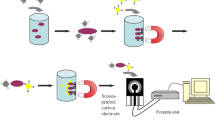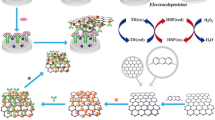Abstract
As a gram-positive foodborne pathogen, Listeria monocytogenes (LM) can cause many serious diseases to the human health coupled with high mortality rates; thus, constructing an effective method to detect LM is of great significance. Herein, a novel sandwich-type electrochemical immunosensor is proposed for LM by introducing 3,4,9,10-perylene tetracarboxylic acid/graphene ribbons (PTCA/GNR) nanohybrids as a sensing platform and ferrocene/gold nanoparticles (Fc/Au NPs) as a signal amplifier. The high conductivity and large surface area of GNR can increase the immobilizing amount of the primary antibody (PAb) and enhance the electron transport rate, while Au NPs can carry secondary antibodies (SAb) and Fc derivative (Fc-SH) to form a SAb-Au NPs-Fc signal amplifier. Through using Fc molecules as a signal probe, its peak current can appear and increase varied from the LM concentrations; hence, a highly sensitive sandwich-type immunosensor was constructed wide linear range from 10 to 2 - 104-CFU mL−1 and low limit of detection of low to 6 CFU mL−1. Furthermore, the specificity of the immunosensor was also studied and a satisfactory result was obtained.
Similar content being viewed by others
References
N. F. D. Silva, M. M. P. S. Neves, J. M. C. S. Magalhães, C. Freire, and C. Delerue-Matos, Trends Food Sci. & Technol., 2020, 99, 621.
J. Ding, J. Lei, X. Ma, J. Gong, and W. Qin, Anal. Chem., 2014, 86, 9412.
X. Qi, Z. Wang, R. Lu, J. Liu, Y. Li, and Y. Chen, Food Chem., 2021, 338, 127837.
S. Eissa and M. Zourob, Microchim. Acta, 2020, 187, 486.
C. Cheng, Y. Peng, J. Bai, X. Zhang, Y. Liu, X. Fan, B. Ning, and Z. Gao, Sens. Actuators, B, 2014, 190, 900.
Q. Chen, J. Lin, C. Gan, Y. Wang, D. Wang, Y. Xiong, W. Lai, Y. Li, and M. Wang, Biosens. Bioelectron., 2015, 74, 504.
B. Giménez, N. Graiver, L. Giannuzzi, and N. Zaritzky, Food Control, 2021, 121, 107602.
B. B. Tasbasi, B. C. Guner, M. Sudagidan, S. Ucak, M. Kavruk, and V. C. Ozalp, Anal. Biochem., 2019, 587, 113449.
S. Wachiralurpan, K. Chansiri, and P. A. Lieberzeit, Sens. Actuators, B, 2020, 308, 127678.
J. Riu and B. Giussani, TrAC, Trends Anal. Chem., 2020, 126, 115863.
X. Niu, W. Zheng, C. Yin, W. Weng, G. Li, W. Sun, and Y. Men, J. Electroanal. Chem., 2017, 806, 116.
A. Liu, L. Shen, Z. Zeng, M. Sun, Y. Liu, S. Liu, C. Li, and X. Wang, Food Anal. Methods, 2018, 11, 215.
N. F. D. Silva, M. M. P. S. Neves, J. M. C. S. Magalhães, C. Freire, and C. Delerue-Matos, Talanta, 2020, 216, 120976.
L. Jothi, S. K. Jaganathan, and G. Nageswaran, Mater. Chem. Phys., 2020, 242, 122514.
P. Zhao, M. Ni, Y. Xu, C. Wang, C. Chen, X. Zhang, C. Li, Y. Xie, and J. Fei, Sens. Actuators, B, 2019, 299, 126997.
K. Kunpatee, P. Chamsai, E. Mehmeti, D. M. Stankovic, A. Ortner, K. Kalcher, and A. Samphao, J. Electroanal. Chem., 2019, 855, 113630.
R. Zhang, C. Zhang, F. Zheng, X. Li, C.-L. Sun, and W. Chen, Carbon, 2018, 126, 328.
G. Zhu, Y. Yi, Z. Liu, H. J. Lee, and J. Chen, Electrochem. Commun., 2016, 66, 10.
E. Mahmoudi, A. Hajian, M. Rezaei, A. Afkhami, A. Amine, and H. Bagheri, Microchem. J., 2019, 145, 242.
Y. Yi, D. Zhang, Y. Ma, X. Wu, and G. Zhu, Anal. Chem., 2019, 91, 2908.
Q. Feng, X. Zhao, Y. Guo, M. Liu, and P. Wang, Biosens. Bioelectron., 2018, 108, 97.
L. Jothi, S. Neogi, S. k. Jaganathan, and G. Nageswaran, Biosens. Bioelectron., 2018, 105, 236.
N. Pajooheshpour, M. Rezaei, A. Hajian, A. Afkhami, M. Sillanpää, F. Arduini, and H. Bagheri, Sens. Actuators, B, 2018, 275, 180.
D. Dziubak, K. Pułka-Ziach, and S. Sęk, J. Phys. Chem. C, 2020, 124, 17916.
M. A. Casulli, I. Taurino, T. Hashimoto, S. Carrara, and T. Hayashita, Small, 2020, 16, 2003359.
N. Rezvani Jalal, T. Madrakian, A. Afkhami, and A. Ghoorchian, ACS Appl. Mater. Interfaces, 2020, 12, 4859.
R. Cruz-Silva, A. Morelos-Gómez, S. Vega-Díaz, F. Tristán-López, A. L. Elias, N. Perea-López, H. Muramatsu, T. Hayashi, K. Fujisawa, Y. A. Kim, M. Endo, and M. Terrones, ACS Nano, 2013, 7, 2192.
F. Cui and X. Zhang, J. Electroanal. Chem., 2012, 669, 35.
G. Goncalves, P. A. A. P. Marques, C. M. Granadeiro, H. I. S. Nogueira, M. K. Singh, and J. Grácio, Chem. Mater., 2009, 21, 4796.
D. Wang, Q. Chen, H. Huo, S. Bai, G. Cai, W. Lai, and J. Lin, Food Control, 2017, 73, 555.
R. Wang, C. Ruan, D. Kanayeva, K. Lassiter, and Y. Li, Nano Lett., 2008, 8, 2625.
D. Davis, X. Guo, L. Musavi, C. S. Lin, S. H. Chen, and V. C. Wu, Ind. Biotechnol., 2013, 9, 31.
Y. Lu, Y. Liu, Y. Zhao, W. Li, L. Qiu, and L. Li, J. Nanomater., 2016, 16, 1.
Acknowledgments
The work was financially supported by the National Natural Science Foundation of China.
Author information
Authors and Affiliations
Corresponding author
Rights and permissions
About this article
Cite this article
Jiang, X., Ding, W., Lv, Z. et al. Highly Sensitive Electrochemical Immunosensing for Listeria Monocytogenes Based on 3,4,9,10-Perylene Tetracarboxylic Acid/ Graphene Ribbons as a Sensing Platform and Ferrocene/Gold Nanoparticles as an Amplifier. ANAL. SCI. 37, 1701–1706 (2021). https://doi.org/10.2116/analsci.21P113
Received:
Accepted:
Published:
Issue Date:
DOI: https://doi.org/10.2116/analsci.21P113




